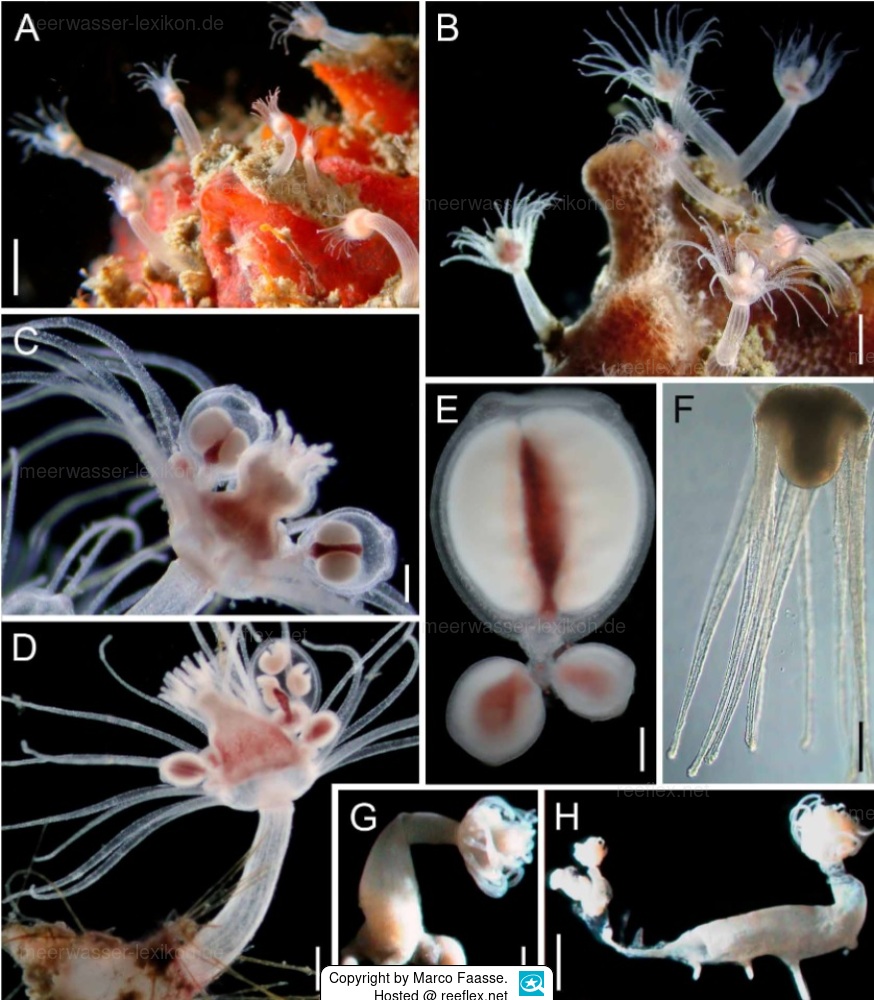Info
Zyzzyzus warreni belongs to the Tubulariidae, a family of cnidarians found exclusively in seawater.
This cnidarian with the unusual scientific genus name forms small clusters of very strong polyps of varying sizes.
The polyps are bright wine-red to deep red and are embedded as individual polyps in sponges.
Due to the thick stalks and the wine-red color, confusion with other species is relatively impossible, although Zyzzyzus warreni is most similar to Zyzzyzus robustustus Petersen, 1990 from Greenland.
The tubular sponge polyp grows to about 1.5 cm in size.
It has a thick stalk and a daisy-like polyp with sparse tentacles surrounding a group of reproductive sporosacs, which in turn surround the pink and white oral tentacles.
The tentacles of the polyps are transparent white[.
Habitat: The polyps settle on algae, vegetation, sea squirts, bryozoans, hydroids, mud, mussels, polychaete tubes, mangrove roots (Rhizophora mangle), rocks, mussels, sponges, wood, and zoanthids.
The nudibranch (Cuthonella punicea) has specialized in feeding on the polyps of this hydrozoan species and has adapted its colour perfectly.
Synonyms:
Tubularia solitaria Warren, 1906 · unaccepted (invalid homonym to Tubularia...)
Zyzzyzus calderi Petersen, 1990 · unaccepted (synonym)
Zyzzyzus solitaria (Warren, 1906) · unaccepted (synonym)
This cnidarian with the unusual scientific genus name forms small clusters of very strong polyps of varying sizes.
The polyps are bright wine-red to deep red and are embedded as individual polyps in sponges.
Due to the thick stalks and the wine-red color, confusion with other species is relatively impossible, although Zyzzyzus warreni is most similar to Zyzzyzus robustustus Petersen, 1990 from Greenland.
The tubular sponge polyp grows to about 1.5 cm in size.
It has a thick stalk and a daisy-like polyp with sparse tentacles surrounding a group of reproductive sporosacs, which in turn surround the pink and white oral tentacles.
The tentacles of the polyps are transparent white[.
Habitat: The polyps settle on algae, vegetation, sea squirts, bryozoans, hydroids, mud, mussels, polychaete tubes, mangrove roots (Rhizophora mangle), rocks, mussels, sponges, wood, and zoanthids.
The nudibranch (Cuthonella punicea) has specialized in feeding on the polyps of this hydrozoan species and has adapted its colour perfectly.
Synonyms:
Tubularia solitaria Warren, 1906 · unaccepted (invalid homonym to Tubularia...)
Zyzzyzus calderi Petersen, 1990 · unaccepted (synonym)
Zyzzyzus solitaria (Warren, 1906) · unaccepted (synonym)







 Marco Faasse, Holland
Marco Faasse, Holland


